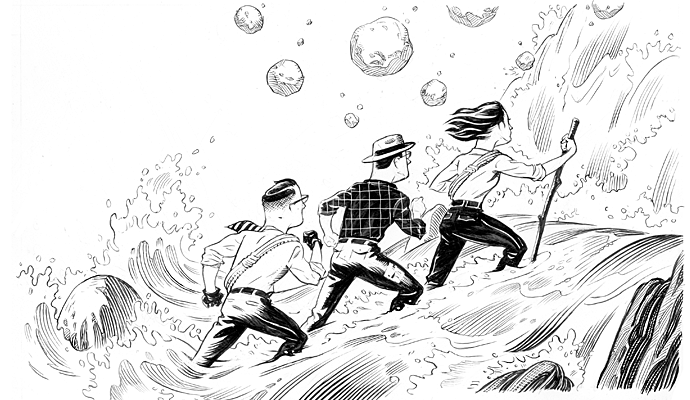The best way to lead in uncertain times may be to throw out the playbook
Rather than follow a rigid blueprint, executives must help organizations focus on sensing and responding to unpredictable market conditions.
In 1993, management theorists Steve Haeckel and Richard Nolan introduced to the business world a concept borrowed from cellular biology, “sensing-responding-adapting.” The idea behind their framework was simple: the introduction of information technology had allowed companies to be more flexible and responsive to changing customer needs and market conditions, which led to a new means of developing strategy. Almost 30 years later, as COVID-19 sent shock waves through global economies, companies revived the sense-respond-adapt playbook as they attempted to evolve faster than the virus.
Working with researchers from the Disaster Recovery Institute International (DRI), my team at the National Preparedness Leadership Initiative at Harvard University (NPLI) interviewed leaders from nine organizations in sectors including aviation, energy, healthcare, higher education, manufacturing, retail, and technology. In launching the 2021 study, we wanted to better understand the nature of COVID-19 crisis management across the global economy to help others navigate the ongoing challenges of the global pandemic and prepare for future disruptions.
What we found was revealing and instructive. Every organization we interviewed sensed, responded, and adapted in some way. At the very beginning of the pandemic, myriad organizations with operations in China sensed trouble brewing in Wuhan through communications channels with employees and suppliers. When it became clear that supply chains and other operations would fracture, organizations began scenario planning to shift production sources, relocate employees, and secure key supplies.
As the virus spread to Europe, many senior executives responded by prioritizing the health and safety of their employees. As one study participant noted, “The CEO stated unequivocally that the company would do everything necessary to protect our people, even though it would hurt our financial position.” Indeed, throughout our study we heard several variations on the mantra “Do the right thing.”
Putting people first required adaptation. Executives needed to shift their mindsets and operational strategies to provide their employees with the necessary social and financial support and remote-working capability. This involved more than just tinkering at the edges of workforce strategy. It meant devising a new playbook. In several cases, we saw evidence of what is known as “double-loop learning,” through which members of an organization question underlying assumptions about their strategies and tactics rather than just making slight modifications to them. One interview participant noted that the pandemic forced the organization’s senior management team to reexamine how all decisions were made. Another told us their organization decided to hold town halls with their CEO for the first time. Town halls gave executive teams a clearer window into employee engagement and morale and helped them understand specific concerns about the virus. In yet another case, the pandemic inspired one organization to allocate more money to mental health programs.
In every case of business failure, the factors leading to collapse were there to be seen if executives had been open to seeing.
Organizations also used the sensing-responding-adapting model to combat misinformation and confusion about masks and vaccines. With conflicting guidance from the Centers for Disease Control and Prevention (CDC) in the US and the World Health Organization (WHO), one organization we studied opted for “full transparency” with a “fully digital” solution. The company built an app that included data from sources the company considered reliable, and it updated policies, outlined precautions, and offered ways to report vaccination status. The app turbocharged the company’s sense-respond-adapt capabilities by getting quality information in everyone’s hands and opening a new channel for regular two-way communication. There was no waiting for an “all hands” meeting to get meaningful questions and feedback.
Reflecting on the results of the study, one takeaway became clear: it’s worthwhile for leaders of any team to absorb the lessons of sense-respond-adapt, even if there is no emergency at hand. Here are three ways to employ each step of the model.
Sensing: Treat the far-flung parts of your enterprise as listening stations. For some organizations, these will be geographically dispersed suppliers. For others, they will be customer service centers. The question leaders must ask is, “What are we learning from our interactions beyond the usual information about costs and sales?” Train your people to listen for potentially significant anomalies, and ensure that important information is not trapped in organizational silos. In our research, we found that during the pandemic C-level executives were engaging directly with business continuity and other relevant functions they might not encounter every day. By moving beyond the “usual suspects,” they were able to hear fresh voices and ask probing questions to reveal faint signals of change on the horizon.
Responding: Improve communication across intra- and inter-organizational boundaries. Leaders should view business continuity as an essential function that acts as connective tissue for the enterprise. Our interviews showed that in highly connected companies, business continuity was working together with business intelligence, supply chain management, human resources, health and safety, and other functions. Managers saw the logic of working together and had the means and inclination to do so. The result was faster identification of major problems and a more efficient system for coming up with solutions.
Adapting: Challenge assumptions, and question orthodoxies. There’s always the temptation to mitigate threats simply by applying existing practices harder and faster. The result can be efforts to conform the incident to the response rather than the other way around. That is a sure path to missteps and potential disaster. One way to get at those deeper issues and encourage double-loop learning is to ask, “What needs to be true for this to be the right approach?” It helps separate evidence-based facts from speculation and conjecture that may underlie assumptions.
In every case of business failure, the factors leading to collapse were there to be seen if executives had been open to seeing. To be sure, there are many filters and barriers that can distort or impede one’s view of reality. But actively adopting and promoting a sense-respond-adapt mindset will better equip you and your team to navigate these turbulent times.





